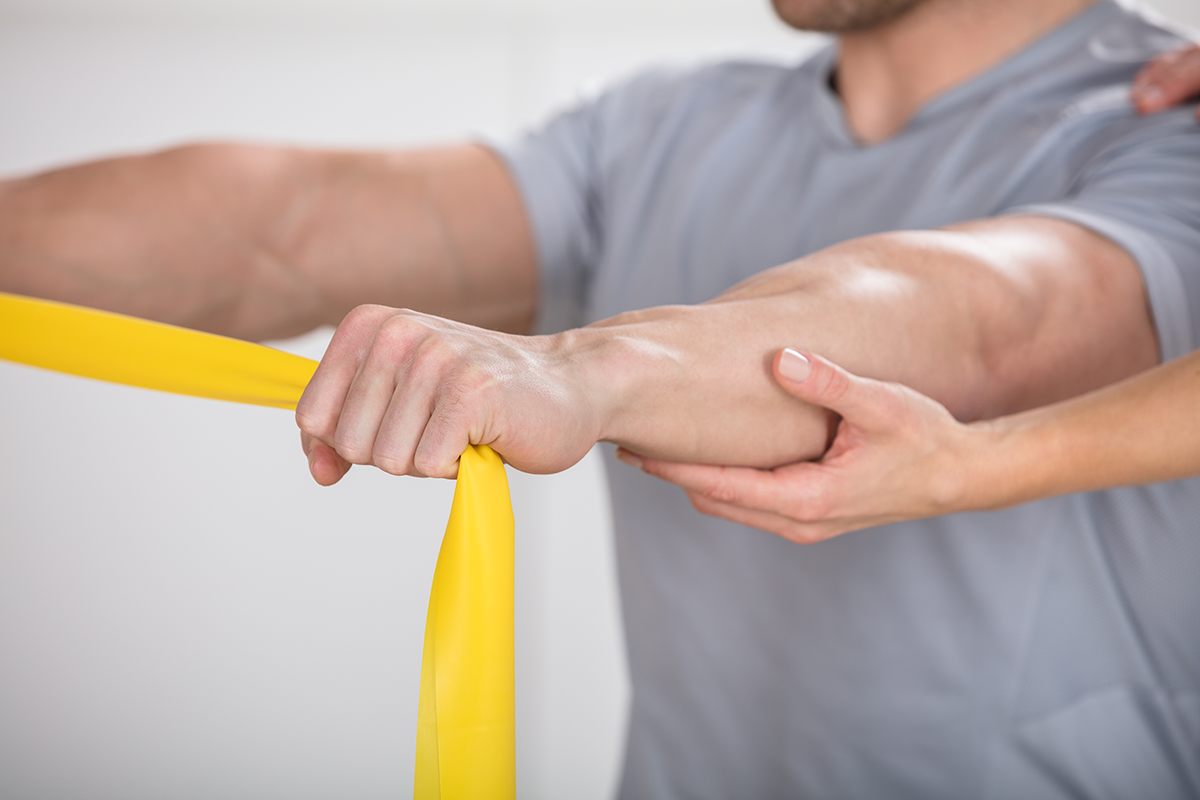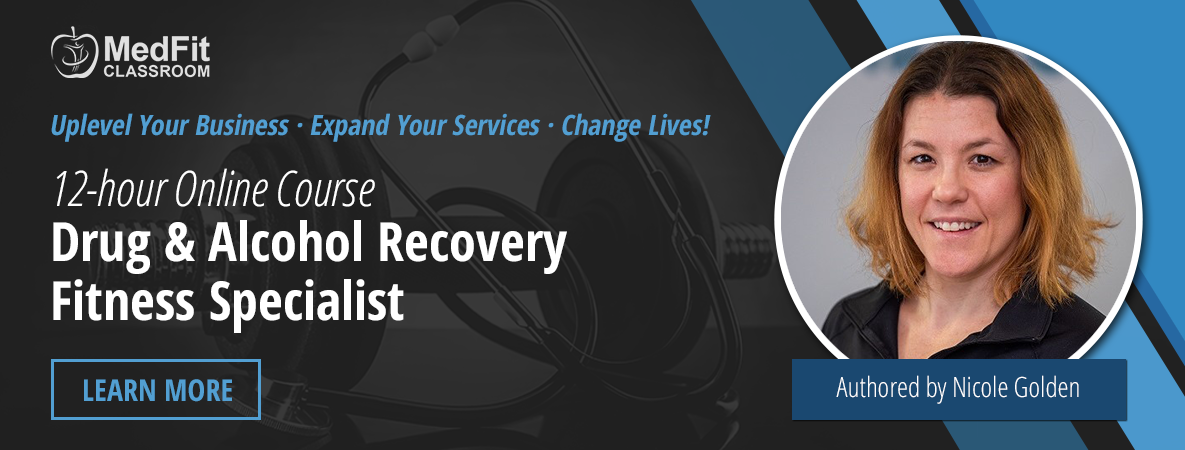This is part 3 in a series; read part 1 here and part 2 here.
Part III: Less Obvious Medical/Psychological Co-Morbidities
Oftentimes, we may consider co-morbidities such as malnutrition, muscle wasting, reduced aerobic capacity, and motor disturbances when working with individuals with a history of Alcohol Use Disorder (AUD). However, there are other considerations that may be less obvious, but of equal importance when designing exercise programming for members of this special population.
Prior Orthopedic Injuries
 Chronic alcohol consumption can lead to poor decision-making and puts users at a higher risk of orthopedic traumas. In fact, Nordqvist and Petersson (1996) investigated 413 shoulder injuries in a retrospective study and found that shoulder injuries were four times as likely in patients with AUD than otherwise healthy adults (Nordqvist & Petersson, 1996). Likewise, Levy et al. (1996) conducted a retrospective study of patients admitted to their orthopedic services between 1993 and 1994. The investigators found that patients with open fractures, patients involved in pedestrian versus motor vehicle collision and gunshot victims had a 25% positive screen rate for alcohol (Levy et al., 1996).
Chronic alcohol consumption can lead to poor decision-making and puts users at a higher risk of orthopedic traumas. In fact, Nordqvist and Petersson (1996) investigated 413 shoulder injuries in a retrospective study and found that shoulder injuries were four times as likely in patients with AUD than otherwise healthy adults (Nordqvist & Petersson, 1996). Likewise, Levy et al. (1996) conducted a retrospective study of patients admitted to their orthopedic services between 1993 and 1994. The investigators found that patients with open fractures, patients involved in pedestrian versus motor vehicle collision and gunshot victims had a 25% positive screen rate for alcohol (Levy et al., 1996).
A variety of orthopedic traumas are possible in this population which could lead to significant movement imbalances and the necessity to modify training plans. The fitness professional must take a careful history to determine which injuries the client may have sustained in the past and plan training programs accordingly.
Psychological Considerations
Exercise is perhaps most beneficial to alleviate some of the psychological effects of AUD. A consistent exercise program can increase self-efficacy, decrease the urge to drink, improve mood, provide a pleasurable state without the use of alcohol and serve as a replacement behavior for drinking (Brown et al., 2008). Similarly, Brown et al. (2009) found that participants who engaged in a 12 weeks exercise program while in recovery showed significantly lower rates of relapse than subjects who did not participate in the program (2009). However, several studies conducted to determine the efficacy of training programs at reducing relapse of AUD found that ongoing follow-up and supervised programs are more likely reduce the incidence of relapse (Manthou et al., 2016). The fitness professional can provide support with regards to adherence to exercise programs and the formation of the exercise habit. The trainer must also be aware of this and provide positive emotional support and coaching accordingly.
Conclusion
An individual in recovery from AUD may experience poor gross motor coordination and proprioception, muscle wasting due to malnutrition and poor aerobic endurance. However, exercise programs have been demonstrated to be greatly beneficial to these clients both physiologically and psychologically. The fitness professional must be aware of potential contraindications to types of exercise and intensity of exercise. The trainer must receive medical clearance for exercise, complete an extended assessment process and careful history prior to planning a training program for individuals in this population. Overall, individuals in recovery from AUD can be a rewarding population to work with and can engage in exercise programs safely and effectively.
Online Course: Drug & Alcohol Recovery Fitness Specialist
Arm yourself with the knowledge & tools to build successful fitness programming for drug and alcohol recovery.
Substance Use Disorder affects a huge number of individuals. More than 20 million Americans are diagnosed with Substance Abuse Disorder. Research has demonstrated that exercise therapy can help these patients a great deal from improving long-term neurological outcomes to relapse prevention. There are physiological and psychological considerations you must understand to design and implement successful exercise programs for this population.
MedFit Classroom’s online course, Drug and Alcohol Recovery Fitness Specialist, will teach you what you need to know.
Nicole Golden is a NASM Master Trainer, CES, BCS, FNS and AFAA certified group fitness instructor and graduate student at Concordia University Chicago where she is earning her Master of Science in Applied Exercise Science/Sports Nutrition. She has been a health/fitness professional since 2014 when she left the field of education to pursue a full-time career in fitness. Nicole is the owner of FWF Wellness where she specializes in corrective exercise, weight loss coaching, nutrition coaching and group fitness.
References
- Brown, R. A., Abrantes, A. M., Minami, H., Read, J. P., Marcus, B. H., Jakicic, J. M., Strong, D. R., Dubreuil, M. E., Gordon, A. A., Ramsey, S. E., Kahler, C. W., & Stuart, G. L. (2014). A preliminary, randomized trial of aerobic exercise for alcohol dependence. Journal of Substance Abuse Treatment, 47(1), 1–9. https://doi.org/10.1016/j.jsat.2014.02.004
- Brown, R. A., Abrantes, A. M., Read, J. P., Marcus, B. H., Jakicic, J., Strong, D. R., Oakley, J. R., Ramsey, S. E., Kahler, C. W., Stuart, G. G., Dubreuil, M. E., & Gordon, A. A. (2009). Aerobic exercise for alcohol recovery: Rationale, program description, and preliminary findings. Behavior Modification, 33(2), 220–249. https://doi.org/10.1177/0145445508329112
- Manthough, E., Geogakouli, K., Fatouros, I. G., Gianoulakis, C., Theodorakis, Y., & Jamurtas, A. Z. (2016). Role of exercise in the treatment of alcohol use disorders. Biomedical Reports, 4(5), 535–545. https://doi.org/10.3892/br.2016.626
- Nordqvist, A., & Petersson, C. J. (1996). Shoulder injuries common in alcoholics: An analysis of 413 injuries. Acta Orthopaedica Scandinavica, 67(4), 364–366. https://doi.org/10.3109/17453679609002332


